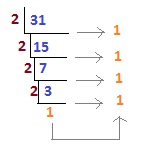I. $(31.500)_{10}$
$31$ can be represented in binary as $(11111)_2$

$(.500)_{10}$ can be represented in binary as $(.1)_2$

∴ $\color{green}{(31.500)_{10} \rightarrow (11111.1)_2}$
II. $(0.875)_{10}$
$0$ can be represented in binary as $0$
$(.875)_{10}$ can be represented in binary as $(.111)_2$

∴ $\color{green}{(0.875)_{10} \rightarrow (.111)_2}$
III. $(12.100)_{10}$
$(12)_{10}$ can be represented in binary as $(1100)_2$

$(.100)_{10}$ can be represented in binary as $(.0001100....)_2$

∴ $\color{green}{(12.100)_{10} \rightarrow (1100.0001100)_2}$
IV.$(3.001)_{10}$
$(3)_{10}$ can be represented in binary as $(11)_2$

$(.001)_{10}$ can be represented in binary as $(.0000....)_2$

∴ $\color{green}{(3.001)_{10} \rightarrow (11.0000....)_2}$
We can easily be seen that $III. \& IV.$ can't be represented in the given format.